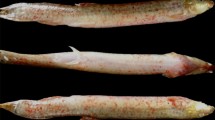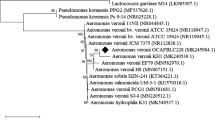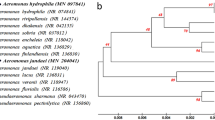Abstract
Studies were conducted to determine the cause of the acute mortality of half-smooth tongue sole Cynoglossus semilaevis Günther juveniles in a fish farm in Jimo, Shandong Province, China, in June 2006. Gross signs of the diseased tongue sole included several petechiae and ecchymoses on the body and fin necrosis and hemorrhagic lesion at the base of the fin. Bacteria were isolated from kidney, liver and hemorrhagic lesions of the diseased tongue sole. Among14 strains, SJ060621 was proved to be highly virulent to juvenile tongue sole with LD50 value of <1.0×105 colony forming units (CFU) mL−1, while the remaining 13 were avirulent. Among the 16 antibiotics tested, SJ060621 was sensitive to gentamicin and nitrofurantoin. It was identified as Listonella anguillarum with conventional plate and tube tests in combination with API 20E analysis. 16S rRNA gene and partial HSP60 gene sequenceing analysis revealed that the strain was highly homologous with L. anguillarum. Examination of the infected musculature by electron microscopy indicated numerous bacteria and lots of macrophages containing phagocytosed bacteria. Histopathological investigations revealed severe necrotic degenerative changes in the infected organs. Indirect immunofluorescence assay (IFA) was employed to detect the location of occurrence of bacteria, and bacteria were found in aggregations in the inflammatory areas in musculature.
Similar content being viewed by others
References
Aoki, T., and T. Kitao, 1981. Drug resistance and transferable R plasmids in Edwardsiella tarda from fish culture ponds. Fish Pathol., 15: 277–281.
Bernadet, J. F., A. C. Campbell, and J. A. Buswell, 1990. Flexibacter maritimus is the agent of black patch necrosis in Dover sole in Scotland. Dis. Aqua. Organ., 8: 233–237.
Fryer, J. L., J. S. Nelson, and R. L. Garrison, 1972. Vibriosis in fish. Prog. Fish Food Sci., 5: 129–133.
Grisez, L. R., R. Ceusters, and F. Ollevier, 1991. The use of API 20E for the identification of Vibrio anguillarum and Vibrio ordalii. J. Fish Dis., 14: 359–365.
Horne, M. T., R. H. Richards, R. J. Robert, and P. C. Smith, 1977. Peracute vibriosis in juvenile turbot Scophthalmus maximus. J. Fish. Biol., 11: 355–361.
Jiang, Y. W., and R. J. Wan, 1988a. Reproductive behaviour and spawning ecology of Cynoglossus semiliaevis Günther in Bohai Sea. Mar. Fish. Res., 9:151–171 (in Chinese with English abstract).
Jiang, Y. W., and R. J. Wan, 1988b. Studies on morphology and characters in early life phases of Cynoglossus semiliaevis Günther in the Bohai Sea. Mar. Fish. Res., 9: 185–192 (in Chinese with English abstract).
Jiang, Y. W., R. J. Wan, R. S. Chen, Y. L. Liu, G. W. Chen, and S. B. Zhang, 1993. Mar. Fish. Res., 14: 25–33 (in Chinese with English abstract).
Kanno, T., T. Nakai, and K. Muroga, 1989. Mode of transmission of vibriosis among ayu, Plecoglossus altivelis. J. Aqua. Anim. Heal., 1: 2–6.
Kanno, T., T. Nakai, and K. Muroga, 1990. Scanning electron microscopy on the skin surface of ayu Plecoglossus altivelis infected with Vibrio anguillarum. Dis. Aqua. Organ., 8: 73–75.
Kawai, K., Y. Liu, K. Ohnishi, and S. I. Oshima, 2004. A conserved 37 kDa outer membrane protein of Edwardsiella tarda is an effective vaccine candidate. Vaccine, 22: 3411–3418.
Kim, Y. B., J. Okuda, C. Matsumoto, N. Takahashi, S. Hashimoto, and M. Nishibichi, 1999. Identification of Vibrio. Parahaemolyticus strains at the species level by PCR targeted to the toxR gene. J. Clin. Microbiol., 37: 1173–1177.
Kwok, A. Y. C., S. C. Su, R. P. Reynolds, S. J. Bay, Y. Av-Gay, N. J. Dovichi, et al., 1999. Species identification and phylogenetic relationships based on partial HSP60 gene sequences within the genus Staphylococcus. Intl. J. Syst. Bacteriol., 49: 1181–1192.
Larsen, J. L., H. B. Rasmuseen, and I. Dalsgaard, 1988. Study of Vibrio anguillarum strains from different sources with emphasis on ecological and pathological properties. Appl. Environ. Microbiol., 54: 2264–2267.
Levin, M. A., R. E. Wolke, and V. J. Cabelli, 1972. Vibrio anguillarum as a cause of disease in winter flounder (Pseudopleuronectes americanus). Can. J. Microbiol., 18: 1585–1592.
Liu, X. Z., Z. M. Zhuang, A. J. Ma, S. Q. Chen, Z. Z. Sun, Y. Liang, et al., 2006. Operative technologies for seedling rearing of Cynoglossus semilaevis Günther. Mar. Fish. Res., 27(2): 25–33 (in Chinese with English abstract).
Ma, A. J., X. Z. Liu, Y. J. Xu, Y. Liang, Z. M. Zhuang, J. M. Zhai, et al., 2005. Study on feeding behavior and growth of tongue sole Cynoglossus semiliaevis in early development stage. Oceanol.Limnol. Sin., 36(2): 130–138 (in Chinese with English abstract).
McVicar, A. H., and P. G. White, 1979. Fin and skin necrosis of cultivated Dover sole, Solea solea. J. Fish Dis., 2: 557–562.
Miyazaki, T., and S. S. Kubota, 1977. Histopathological study on vibriosis of the salmonids. Fish Pathol., 12: 93–98.
Miyazaki, T., J. Yasuhika, S. S. Kubota, and S. Egusa, 1977. Histopathological studies on vibriosis of the Japanese eel (Anguilla japonica)-I. Natural infection. Fish Pathol., 12: 163–170.
Muroga, K., and M. C. De la Cruz, 1987. Fate and location of Vibrio anguillarum in tissues of artificially infected ayu (Plecoglossus altivelis). Fish Pathol., 22: 99–103.
Ransom, D. P., C. N. Lannan, J. S. Rohovec, and J. L. Fryer, 1984. Comparison of histopathology caused by Vibrio anguillarum and Vibrio ordalii in three species of Pacific salmon. J. Fish. Dis., 7: 107–115.
Rodgers, C. J., and M. D. Furones, 1998. Disease problems in cultured marine fish in the Mediterranean. Fish Pathol., 33: 157–164.
Spanggaard, B., I. Huber, J. Nielsen, T. Nielsen, and L. Gram, 2000. Proliferation and location of Vibrio anguillarum during infection of rainbow trout, Oncorhynchus mykiss (Walbaum). J. Fish Dis., 23: 423–427.
Tajima, K., Y. Ezura, and T. Kimura, 1985. Studies on the taxonomy and serology of causative organisms of fish vibriosis. Fish Pathol., 20: 179–183.
Toranzo, A. E., A. M. Baya, B. S. Roberson, J. L. Barja, D. J. Grimes, and F. M. Hetrich, 1987. Specificity of slide agglutination test for detecting bacterial fish pathogens. Aquaculture, 67: 81–97.
Toranzo, A. E., B. Novoa, J. L. Romalde, S. Nunez, S. Devesa, E. Marino, et al., 1993. Microflora associated with healthy and diseases turbot (Scophthalmus maximus) from theree farm in northwest spain. Aquaculture, 114: 189–202.
Toranzo, A. E., Y. Santos, I. Bandin, J. L. Ramalde, A. Ledo, B. Fouz, et al., 1990. Five year survey of bacterial fish infection in continental and marine aquaculture in northwest Spain. World Aquacult., 21: 91–94.
Wan, R. J., Y. W. Jiang, and Z. M. Zhuang, 2004. Morphological and developmental characters at the early stage of the tonguefish Cynoglosus semilaevis. Acta Zool. Sin., 50: 91–10 (in Chinese with English abstract).
Zhang, W. N., L. Zhou, J. Xing, and W. B. Zhan, 2006. Isolation and identification of pathogen SR1 associated with swollen abdomen of cultured turbot (Scophthalmus maximus). J. Fish. Sci. Chin., 13(4): 603–609 (in Chinese with English abstract).
Author information
Authors and Affiliations
Corresponding author
Rights and permissions
About this article
Cite this article
Tang, X., Zhou, L. & Zhan, W. Isolation and characterization of pathogenic Listonella anguillarum of diseased half-smooth tongue sole (Cynoglossus semilaevis Günther). J. Ocean Univ. China 7, 343–351 (2008). https://doi.org/10.1007/s11802-008-0343-3
Received:
Accepted:
Published:
Issue Date:
DOI: https://doi.org/10.1007/s11802-008-0343-3




